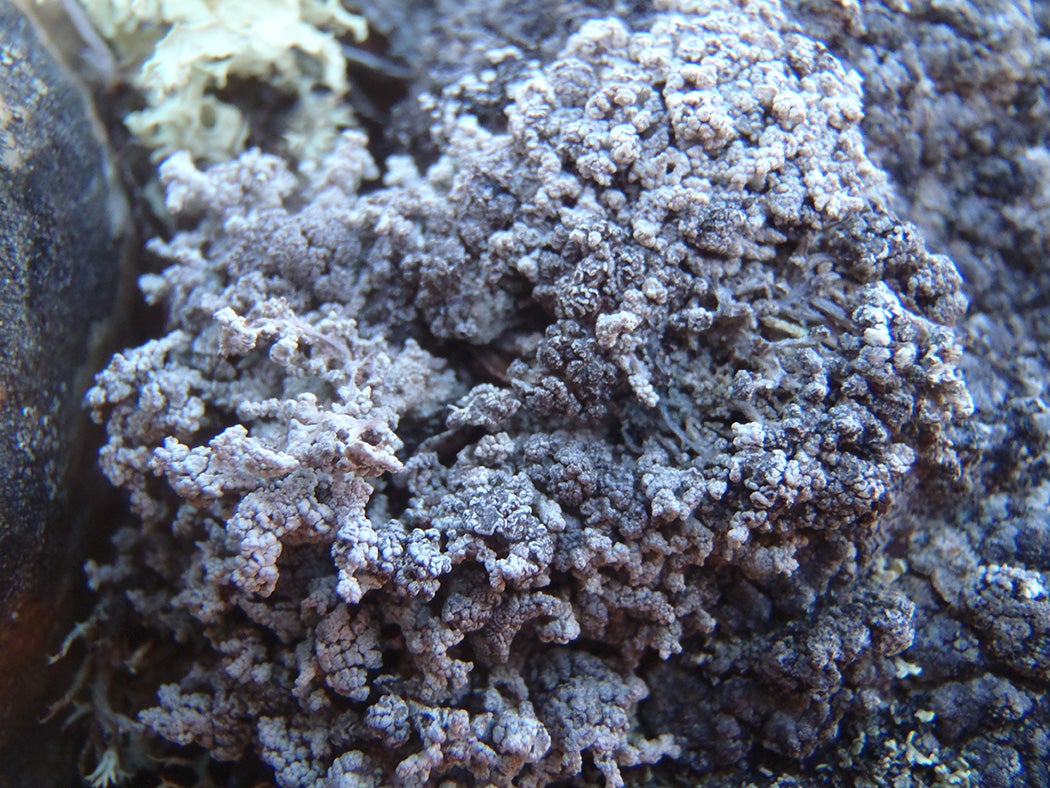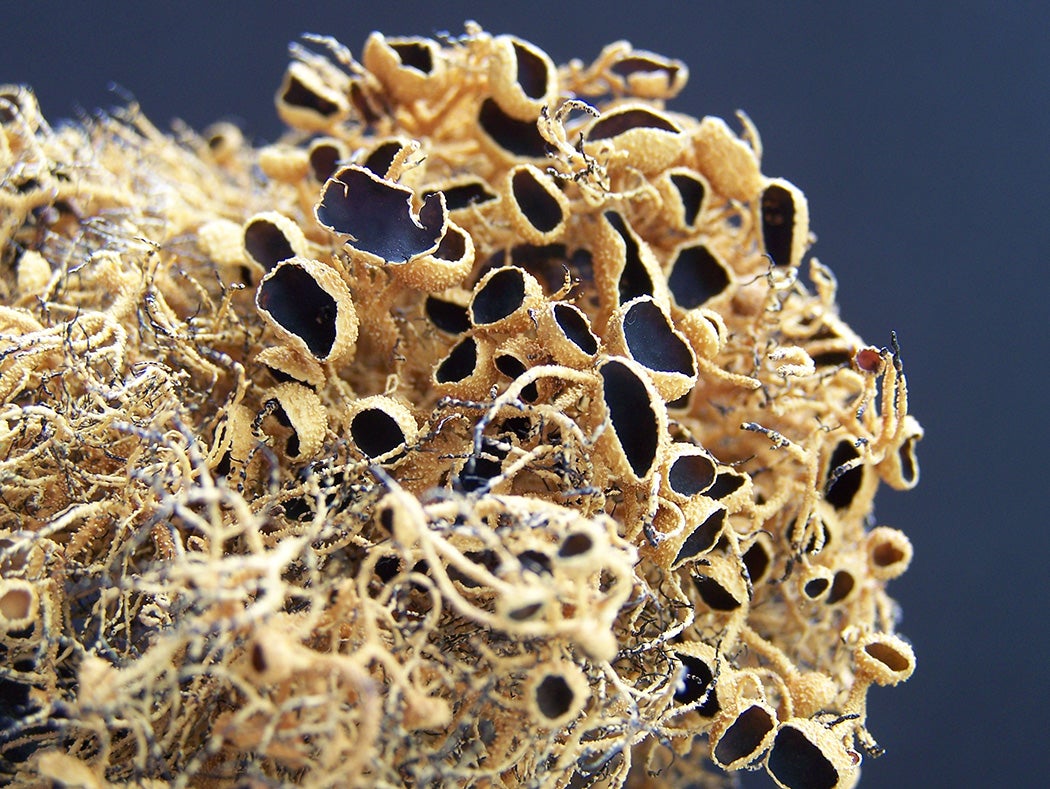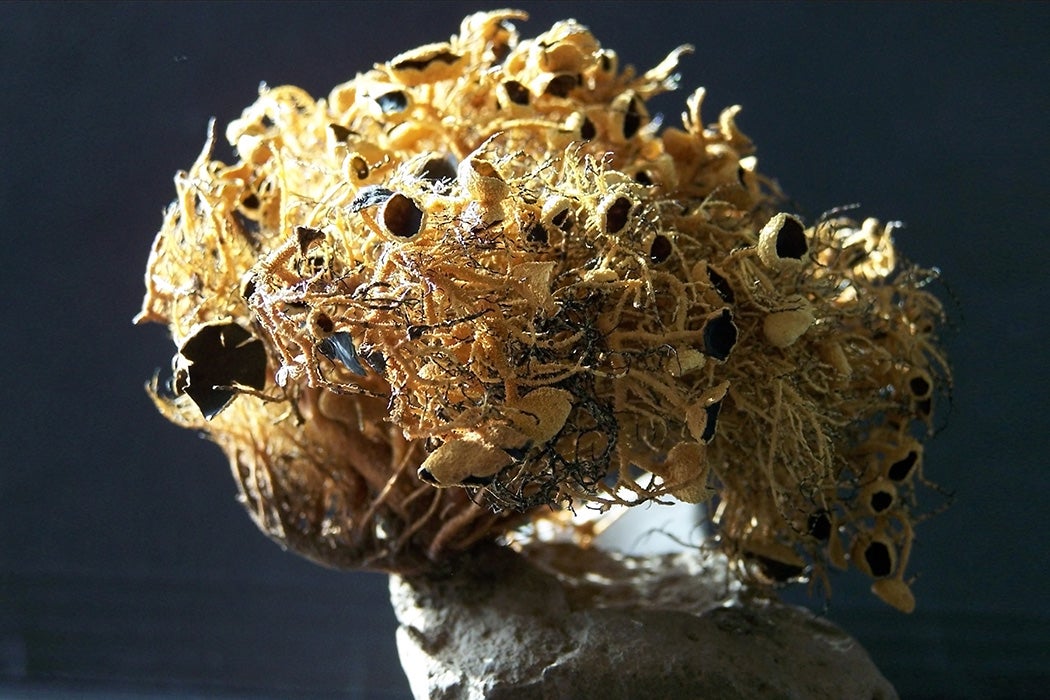In the middle of the twentieth century, a lichenologist named Elke Mackenzie labored to prepare a monograph on Stereocaulon, a genus of lichen. The monograph was to be exhaustive: a tome on how the lichen evolved and took its pale, knurled form, complete with detailed illustrations and photographs. Compared to some of its muted, flatter brethren, Stereocaulon lichens could be considered flamboyant. The lichen effloresce in clusters of knobby stalks called pseudopodetia, branching elongations of its body. One species, S. arenarium, resembles, among other things: a fractal cauliflower; a tangle of silly string; a brain coral, dusted in snow.
Due to a string of unfortunate incidents—windswept specimens, a fall down an elevator shaft, and financial woes—the monograph was never completed. But Mackenzie’s meticulous, exhaustive attention to the genus remains the single greatest contribution to science’s modern understanding of Stereocaulon—and other lichens that dwell in the cold, harsh regions of the Earth.
Weekly Newsletter
Mackenzie, who died in 1990, transitioned in the final years of her career. Despite this, almost all of Mackenzie’s legacy exists under her former name. I chose not to share it here because I do not know Mackenzie’s relationship to her former name, and she has no way of consenting to its inclusion in this story. When Mackenzie transitioned, she shared her news with little fanfare: a small announcement in the October 1976 issue of the International Lichenological Newsletter, where she noted she “should now be addressed as Dr. Elke Mackenzie.” But four years earlier, in one of the last studies she published—“Stereocaulon arenarium… a hitherto overlooked boreal-arctic lichen”—in the 1972 issue of Occasional Papers of the Farlow Herbarium of Cryptogamic Botany, Mackenzie named herself in the acknowledgements of the paper:
Grateful acknowledgement is also due to Dr. Eric Hultén (Stockholm) and Dr. Vsevolod P. Savicz (Leningrad) for advice on the situation of localities in Kamtchatka, and to Miss Elke Mackenzie for technical and bibliographic assistance in the preparation of this paper.
If other scientists were not willing to acknowledge her contributions by name, she would do it herself.
Elke Mackenzie was born in London in 1911, a time when the field of lichenology still held enormous mystery. Scientists had believed for centuries that the pastel encrustations were plants, occupying some interstitial space between algae and fungi on the tree of life. In 1867, the Swiss botanist Simon Schwendener proposed that lichens exist in duality as the physical incarnation of a partnership between fungi and algae, as the botanist Rosmarie Honegger writes in a 2000 article in The Bryologist. Schwendener’s hypothesis was roundly rebuffed by the world’s leading lichenologists until it was proven right at the end of the nineteenth century.
According to an obituary of Mackenzie by the lichenologist George A. Llano, published in a 1991 issue of The Bryologist, her fascination with lichens sparked in 1935, when she landed a job as an assistant at the Natural History Museum in London, then called the British Museum (Natural History). Mackenzie apprenticed under Annie Lorrain Smith, one of Britain’s most revered lichenologists, who authored a textbook in 1921, Lichens, that remained the standard for much of the twentieth century. Though Smith worked at the museum for four decades, the museum did not hire women for official staff positions at the time, so Smith was paid via a separate fund. Under Smith’s mentorship, Mackenzie began studying the museum’s specimens of lichens collected from Antarctica. Little was known about these far-flung species, and Mackenzie took up the mantle.
A year later, Mackenzie married Maila Elvira Laabejo, who gave birth to their first child in 1940 amid a hailstorm of bombs dropped by German planes in a months-long campaign. In the final years of the war, Mackenzie stole away to Antarctica as a part of “Operation Tabarin,” a top secret expedition meant to strengthen Britain’s territorial claims on the southernmost continent, under the guise of protecting Allied ships from German U-boats.
There, Mackenzie wore many hats, including botanist and musher of dogs, one of whom was named Dainty. In Mackenzie’s typewritten diary entries, she chronicled a rugged, hostile life briefly interrupted by moments of joy. There were the quintessentially dour encounters with frostbite and animal carcasses. But there were also afternoons of igloo-building, evenings of fried seal steaks, and nights watching the sunset fade into bright starlight. During one lunchtime pitstop, Mackenzie wandered away from camp to collect the lichen Alectoria minuscula, which tufted a metamorphic rock in “neat black rosettes,” she wrote.
There were lichens in abundance: encrustments by penguin nests, sea cliffs, erratic boulders, shores studded by fossilized ammonites. Mackenzie recorded these encounters with resolute awe. She wrote in one January entry:
At one place, where small rivulets of snowmelt water irrigate stony slope, there is a wonderful profusion of moss, mostly Polytrichum, of a most vivid green colour and forming cushions up to 2 feet across—the most luxuriant moss growth I have ever seen.
To ensure her specimens would survive the harried pace of sledging trips, Mackenzie nestled the lichens she collected in pemmican boxes filled with soft snow and dried them out on heated stones back at camp. There, Mackenzie’s passion was palpable. A medical officer remembered that she encouraged even the most uninterested of her expedition companions to take an interest in lichens. By the end of the journey, Mackenzie had amassed 1,030 specimens, 865 of which were lichens.

When Tabarin concluded, Mackenzie took jobs in Argentina and Canada before becoming the director of the Farlow Herbarium at Harvard, where she would work until retirement. But the one constant in her life remained Stereocaulon. Any lichenologist will tell you that Stereocaulon is a handsome but difficult genus. Some of the 130 or more species of Stereocaulon grow in open boreal forests, on siliceous bedrock and boulders, on the sandy edges of roads. The species are often hard to distinguish from one another, Stephen Clayden, a curator emeritus of botany and mycology at the New Brunswick Museum in Canada, told me.
“Take all the hardwood trees, such as maples, elms, ashes, and birches, and shrink them down until they were an inch in size, and all you had to differentiate them was distinctions in the shape of the leaves,” he said. “You can imagine the challenges.” This minute subtlety renders Stereocaulon more vexing to classify than many other lichens, organisms that famously elude easy classification.
Mackenzie collected and desiccated Stereocaulon specimens for 30 years in preparation of the monograph she hoped would be the magnum opus of her career. She had built a reputation as a meticulous lichenologist and taxonomist, and the leading international authority on Stereocaulon, Clayden said. The genus’s variable nature makes Mackenzie’s research all the more impressive, as she classified species based largely on these tiny distinctions and how she suspected they developed and evolved. Researchers now rely on genetic analysis to elucidate differences between species.
But Mackenzie’s years of hard work and dedication were foiled by what might be called bad luck. In one instance, after several weeks of collecting lichens in mountains near Tucumán, Argentina, a steely gust of wind untied the string holding bundles and bundles of her collections, which tumbled thousands of feet, littering the valley with white herbarium paper. In the 1950s and 1960s, burdened by a number of debts, Mackenzie was forced to sell a number of her collections and live in the Farlow.
Around this time, Mackenzie’s mental health was rapidly deteriorating, and she was hospitalized for three weeks. After separating from her wife, Mackenzie found a specialist in New York City, who diagnosed her with dysphonia syndrome—a voicebox disorder. When Mackenzie told Llano, the lichenologist who wrote her obituary, about her plans to transition, Llano asked if she might have second thoughts. Mackenzie told him there were times when she had contemplated suicide, Llano writes. She also assured him it would not affect her research, indicating her clear desire to continue her scholarship.
In her final years at Harvard, Mackenzie joined a theater troupe in Cambridge, MA, directed by Laurence Senelick, a now-retired professor of drama at Tufts University. In 1969, for her final performance in Ken Campbell’s comedy Anything You Say Will Be Twisted, Mackenzie asked to be credited as Elke. Soon after, she asked to attend one of Senelick’s Oktoberfest parties in women’s clothing, a “coming-out in an environment she assumed would be welcoming,” Senelick told me in an email. “‘Of course,’ I said.”
Mackenzie’s obituaries note that she retired from the Farlow in 1972, a seemingly premature decision, as she was just 60 years old. They also claim that she lost interest in botany. While there is no record of the official reason behind her retirement, Senelick remembers hearing that Mackenzie’s department was “appalled” to learn of her transition and offered her early retirement. “I admired her courage in deciding to live as she wanted, at an advanced age, jeopardizing a secure position,” Senelick said.
After her early retirement, Mackenzie continued to work on her Stereocaulon manuscript in the library on nights, weekends, and holidays, according to Donald F. Pfister, the curator of the Farlow, who met Mackenzie when he was a graduate student. “This was really a life work,” Pfister wrote in an email, adding that her research filled a critical gap in lichenography. “These were exceptional accomplishments.”
Mackenzie published infrequently throughout her career, producing just four major works between 1939 and 1968. This pace did not reflect any kind of sluggishness, but rather a painstaking work ethic. Mackenzie intended for all of her work to be exhaustive, comparing specimens from as many locations as possible to avoid taxonomic redundancy. Her scrupulousness sparked an ongoing rivalry with Carroll W. Dodge, a lichenologist infamous for describing heaps of new, reportedly endemic Antarctic species based on lone fragments of the lichens. In Mackenzie’s eyes, Dodge’s taxonomy was reckless (Clayden corroborates this account, adding that he often revised Dodge’s identifications of specimens at the New Brunswick Museum).
In 1977, Mackenzie published her final conspectus on Stereocaulon, which Clayden sees as “a kind of hypothesis on Stereocaulon’s major natural patterns long before anyone could have anticipated that molecular biology could provide insights.” Many of Mackenzie’s ideas and taxonomic groupings stand up to preliminary molecular research, Clayden says. “I have tremendous admiration for the work she did,” he says. “I wish I’d met her.”
Details concerning the final years of Mackenzie’s life are sparse. In 1976, she retired to an A-frame bungalow in Costa Rica. When she returned to Cambridge in 1980, she struck up a new hobby. “A chance visit to Salem’s Peabody Maritime Museum started her interest in making reproductions of whaler’s sea chests, including fancy knotwork for the handles,” Llano writes. In 1983, Mackenzie was diagnosed with the neurological disease amyotrophic lateral sclerosis, or ALS, and passed away seven years later.

Today, Mackenzie’s scientific papers, her presence in the archives, and a collection of her diaries at Tabarin published in 2018 are all attributed to her former name. That name remains the namesake of five species of lichens and one genus of green algae. She is misgendered in her scientific obituaries, one of which refers to Elke as the scientist’s “alter ego.” This may have been understandable if Mackenzie hid her identity from the lichenological community at large. But it is clear she did not. In her conspectus, the culminating work of her career, she cited herself in a footnote following her former name.
More than 1,190 of Mackenzie’s specimens remain in the Farlow collections, a vast assemblage still consulted by professional and amateur researchers around the world. Her Antarctic specimens in particular have taken on significant newfound value as climate change warms the Earth’s poles, according to Michaela Schmull, the Harvard University Herbaria director of collections. Her final specimen, or at least the final specimen recorded in the herbarium’s database, is the brown alga Pylaiella littoralis, which she collected in 1973 from mudflats in Maine. Though the typewritten label header is listed under her deadname, it cites another collector: E. Mackenzie.
Geologic time does not remember all kinds of life equally. The earth often preserves only hard creatures—or the hard parts of creatures—for future generations to learn from, leaving us with heaps of ammonites and dinosaur bones but precious little record of the softer life forms. “Unhappily the geological record can tell us little about how lichens evolved; lichens do not fossilize readily,” Mackenzie wrote in an article published in Scientific American in 1959.
It is always hard to descry a person’s experience from the scientific record, from vast notes on collections: obscure descriptions of even more obscure fungi. This task becomes near impossible when the best-recorded parts of a person’s life may not accurately reflect their identity. But Elke Mackenzie’s fleeting moments of self-citation—writing herself into her own authorship, even in a footnote—illuminate the hopes of someone who, against ease and tradition, did not wish to separate her identity from her research. They offer a glimpse into what might have been the most peaceful parts of Mackenzie’s career: a retired scientist, typing out the culmination of her scholarship from a self-built bungalow in tropical Costa Rica. A 61-year-old woman wandering a muddy beach in search of patches of green, continuing her life’s work.







